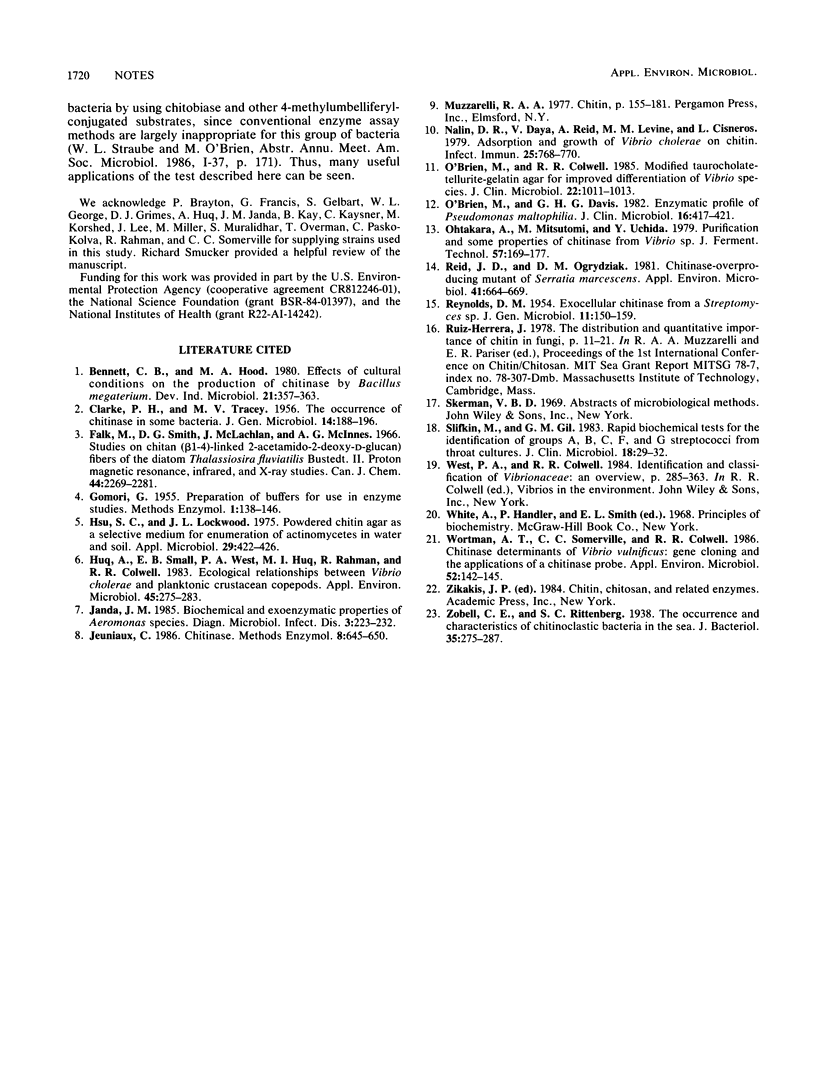Abstract
A total of 101 strains of bacteria from environmental and clinical sources, most of which were gram negative, were tested for chitobiase activity by using a filter paper spot test with 4-methylumbelliferyl-N-acetyl-beta-D-glucosaminide as the substrate. The results were compared with those obtained by a conventional plate method for chitinase activity by using colloidal chitin as the substrate. There was excellent agreement in the results for both methods. The filter paper spot test with 4-methylumbelliferyl-N-acetyl-beta-D-glucosaminide has the advantages of being rapid, simple to perform, and inexpensive. This method should be adaptable to a wider range of microorganisms, particularly those with unusual growth requirements.
Full text
PDF


Selected References
These references are in PubMed. This may not be the complete list of references from this article.
- CLARKE P. H., TRACEY M. V. The occurrence of chitinase in some bacteria. J Gen Microbiol. 1956 Feb;14(1):188–196. doi: 10.1099/00221287-14-1-188. [DOI] [PubMed] [Google Scholar]
- Hsu S. C., Lockwood J. L. Powdered chitin agar as a selective medium for enumeration of actinomycetes in water and soil. Appl Microbiol. 1975 Mar;29(3):422–426. doi: 10.1128/am.29.3.422-426.1975. [DOI] [PMC free article] [PubMed] [Google Scholar]
- Huq A., Small E. B., West P. A., Huq M. I., Rahman R., Colwell R. R. Ecological relationships between Vibrio cholerae and planktonic crustacean copepods. Appl Environ Microbiol. 1983 Jan;45(1):275–283. doi: 10.1128/aem.45.1.275-283.1983. [DOI] [PMC free article] [PubMed] [Google Scholar]
- Janda J. M. Biochemical and exoenzymatic properties of Aeromonas species. Diagn Microbiol Infect Dis. 1985 May;3(3):223–232. doi: 10.1016/0732-8893(85)90034-3. [DOI] [PubMed] [Google Scholar]
- Nalin D. R., Daya V., Reid A., Levine M. M., Cisneros L. Adsorption and growth of Vibrio cholerae on chitin. Infect Immun. 1979 Aug;25(2):768–770. doi: 10.1128/iai.25.2.768-770.1979. [DOI] [PMC free article] [PubMed] [Google Scholar]
- O'Brien M., Colwell R. Modified taurocholate-tellurite-gelatin agar for improved differentiation of Vibrio species. J Clin Microbiol. 1985 Dec;22(6):1011–1013. doi: 10.1128/jcm.22.6.1011-1013.1985. [DOI] [PMC free article] [PubMed] [Google Scholar]
- O'Brien M., Davis G. H. Enzymatic profile of Pseudomonas maltophilia. J Clin Microbiol. 1982 Sep;16(3):417–421. doi: 10.1128/jcm.16.3.417-421.1982. [DOI] [PMC free article] [PubMed] [Google Scholar]
- REYNOLDS D. M. Exocellular chitinase from a Streptomyces sp. J Gen Microbiol. 1954 Oct;11(2):150–159. doi: 10.1099/00221287-11-2-150. [DOI] [PubMed] [Google Scholar]
- Reid J. D., Ogrydziak D. M. Chitinase-overproducing mutant of Serratia marcescens. Appl Environ Microbiol. 1981 Mar;41(3):664–669. doi: 10.1128/aem.41.3.664-669.1981. [DOI] [PMC free article] [PubMed] [Google Scholar]
- Slifkin M., Gil G. M. Rapid biochemical tests for the identification of groups A, B, C, F, and G streptococci from throat cultures. J Clin Microbiol. 1983 Jul;18(1):29–32. doi: 10.1128/jcm.18.1.29-32.1983. [DOI] [PMC free article] [PubMed] [Google Scholar]
- Wortman A. T., Somerville C. C., Colwell R. R. Chitinase determinants of Vibrio vulnificus: gene cloning and applications of a chitinase probe. Appl Environ Microbiol. 1986 Jul;52(1):142–145. doi: 10.1128/aem.52.1.142-145.1986. [DOI] [PMC free article] [PubMed] [Google Scholar]
- Zobell C. E., Rittenberg S. C. THE OCCURRENCE AND CHARACTERISTICS OF CHITINOCLASTIC BACTERIA IN THE SEA. J Bacteriol. 1938 Mar;35(3):275–287. doi: 10.1128/jb.35.3.275-287.1938. [DOI] [PMC free article] [PubMed] [Google Scholar]


